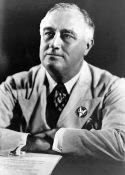John Collier. "Polish Immigrant Husking Corn." Greenfield (vicinity), Connecticut. October 1941. FSA-OWI photo collection, Library of Congress. http://www.loc.gov/pictures/item/fsa2000051872/PP/
Wednesday, November 25, 2015
Wednesday, November 18, 2015
Rescuing Refugees
Ralph M. Faust in 1945, as principal of Oswego High School, Oswego, New York
Saturday, June 20, 2015 was World Refugee Day. I was invited, thanks to the good offices of Nola Heidlebaugh, to accept on behalf of my late uncle Ralph the Ralph M. Faust Humanitarian Award--awarded to Ralph M. Faust, who was principal of Oswego High School in Oswego, New York (1939-1964). In 1944, President Franklin Roosevelt authorized the establishment of a refugee shelter at Fort Ontario, in Oswego, New York, which is now the Safe Haven Museum and Education Center. The Ralph M. Faust Humanitarian Award was presented for the first time this year and is expected to be an annual award. In 1944, 983 refugees, mostly Jewish, were brought to the center from Italy, to which they had fled from all over Europe to escape Nazi persecution. When they arrived in Oswego, Ralph M. Faust played a leading role in welcoming them to the community and arranged for 40 of them to attend Oswego High School. He is remembered as a hero by many of the refugees, who were eventually allowed to immigrate and apply for citizenship. They left the camp in January 1946. The photograph shows Ralph Faust in 1945, from the Oswego High School yearbook. See also the short video about the refugees -- https://youtu.be/I1eptVZhoCk
Monday, November 16, 2015
Peace for Paris
Peace for Paris. Designed by Jean Jullien.
Some links on the story of this design, which is circulating rapidly after the recent attacks in Paris--
"French Artist Tells How He Created 'Symbol of Peace for Paris.'" Time.
Fast Co. Design
Tuesday, November 3, 2015
No Nixon Agnew War -- artist identified as Karl Kasten
"No Nixon Agnew War." Poster, silk screen. Artist: Karl Kasten. From the Thomas W. Benson Political Protest Collection, Penn State University libraries.
The artist has been identified as Karl Kasten, a professor of art practice at Berkeley in 1970. Source: note to the author from Phil Allen, received November 3, 2015 (see next note on blog). The poster is Plate 20 in Thomas W. Benson, Posters for Peace: Visual Rhetoric and Civic Action (University Park: Pennsylvania State University Press, 2015).
Run This One Up Your Flagpole, Dick -- artist comes forward
"Run this one up Your Flagpole, Dick!" Poster, silk screen, Berkeley, California, c. May 1970. Artist: Phil Allen. The poster is in the Thomas W. Benson Political Protest Collection at the Pennsylvania State University libraries.
Since the publication of Posters for Peace: Visual Rhetoric and Civic Action (University Park: Penn State University Press, 2015) I have been hoping that some of the unknown artists who designed and screened these posters would come across the book and get in touch with me to reveal something more about the origins, organization, and aftermath of the posters, which were produced at the University of California, Berkeley, in the weeks after the U. S. invasion of Cambodia and the killings at Kent State University and Jackson State College.
Just yesterday, one of the artists, Phil Allen, came forward to identify himself as the artist of the poster "Run this on up Your Flagpole, Dick!" Here is his note (reproduced here with permission):
-----
-----------Dear Prof. Benson,..I'm glad I thumbed through the copy of Posters for Peace newly displayed at my local city library, as two of the depicted posters --screened at UC-Berkeley in the Spring of 1970--hold more-than-routine attention.I designed/screened the one shown in Plate 18. It gave me a chance to exercise my newly-recovered (childhood) interest in flags, and include 'clever' language and an Oliphant-like caricature of Mr. Nixon. The registration number '4973' was shared by other artists, as required by some quasi-authority in charge of the liberated classroom in Kroeber Hall. The slanted line and triangle is my stylized monogram. Vexillarily, I've since gone on design and research flags. If there is an authority on the football penalty flag, I am he.Plate 20 was the work of one of my art-practice professors, Karl Kasten. It has a level of quality missing in most of the others we cranked out. Nice of him to include one of the lesser grim personalities of the era.Plates 27, 31, and 53 have always been particularly effective for me. 27 and 53 were to me something of a personal invitation to wrestle with inner beliefs and outward commitment, and 31 is possibly the most enduring single image of all our creations. I still see it around.Many folks hereabouts had quite a time of it recently, as last autumn the 50th anniversary of the Free Speech Movement was celebrated with many gatherings, albeit with fewer notables due to death. I found myself unable to get involved in '64, still being in high school at the time, and full of adult envy. I decided to be a grump about it last year until I realized that my time came during that highly-charged, far less remembered Spring of 1970: Cambodia's invasion and 4-5 more killings at Kent/Jackson, and locally...Peoples' Park (1 more death); many energized youth who got progressives elected to state and national office, and those posters. When 2020 comes around, I'll be ready.phil allen, Cal '71 (Art)
If this posting reaches anyone who was one of the artists, or who knows one of the artists, I hope you will come forward so that we can continue to add more fully to the historical account. Please consider sharing this on Facebook and other social media, so that it might eventually reach some of the other artists.
See also Amerika Is Devouring Its Children
Subscribe to:
Posts (Atom)























